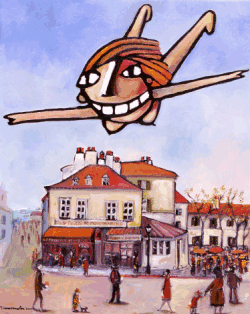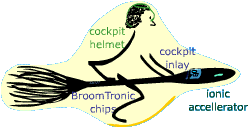|
Broom Development
Broom Equipment Development |
||
Broom Development |
||
RequirementsThe search for the ideal broom material is as old as the modern racing brooms. For the first rediscoverers of the flying broomstick, the most important qualtiy of both, handle and twigs was a light weight construction. Therfore, they prefered ash and spruce. With the spellset's growing importance and abilities, the wood's magical quality moved to the limelight. And so did the spells, the sphere of their activity and their magical interrelations. New facilities for enchanted brooms are invented constantly all over the world. Indeed, a handful of craftshops specialize in developing new broom models and improving brooms already on the market. They send their marketizing application to the iBa M&A (Marketability & Testing department of the International Broomriding Association) or to the AIDBV (Association International du Dévelopment du Balay Volant) in order to get approval for the introduction of new products to the market. |
||
|
According to the world's broomriding organisations, new broom models must fulfill the following requirements:
|
 |
|
Material StudiesThe discussion, which wood will provide the best broom, began a century ago. Can broomriders use the protective forces of holly? The sheltering powers of birch or willow? The inner spiritual strength of oak? The storm-sheltering and harmony generating forces of ash? Yes, they can. And for several decades, broommaker's workshops perfected their skills to combine the most effective woods with the most effective spells. It is still possible to find such individual pieces on the market. But then, a generation of new and better focussed spells surpassed every wood's magical ability. The broom's material quickly became less important compared to the perfectness of the spells, now used in a set. |
Today, the most commonly used handles are ash, fir or oak, while hazle or cypress twigs bound to one end of the handle for the faggot. Some people, howeveer, swear by choosing the wood of their brooms according to their Celtic Astrology. |
|
Tree Nurseries
|
|
|
Broom Tying and Flying Carpets: Bradfort (GB)As we read in the Edinburgh fragment Crookshanks, experiments with the combination of energy fields of bewitched brooms go back as far as the mid 1980s in Scottland, perhaps even before, although we have no other written testimony of such. Tying two bewitched brooms under certain, repeatable circumstances enlarges the energy fields of each broom. Interferences of magical materials strengthen these effects, as well as the tying material which is ideally carpet thread from Turkey, Iraq or Iran. As you see in the image at the right, the interfering spells seem to float and form a common wave-like spellset. Additional spells, as a British-Pakistani cooperation group in Bradfort discovered in the course of their experiments, fill the waves and make the tied broom group like a raft flying vehicle able to transport several people at once. Different woods and different broom models cause different interference patterns and therefore need other additional spells. Flap-n-Ups for instance are impossible to tie, whereas Storks, especially popplar or olive tree Storks, are ideal for the purpose. Three tied popplar Storks can transport up to 10 persons luggage inclusive and three tied olive tree brooms are are the ideal foundation for a comfortable children's room. |
|
|
Object Bewitchment and Free Flying
|


a swiss free flyer's memories |
|
Bewitched Garments as Energy Source
|
||
Dealing with Cold, Wind and Rain
|
Angelus Aegean's Aerodynamic Shell (AAAS) was supposed to be THE INVENTION of the year 1999. But he's not resting on his success. Far from it! His ideas to improve the AAAS seem to explode:
Today, a team of specialists are working at his factory: two co-developers, five fine-tuners of the spells, 8 serial bewitcher of the ordered prototype models, as well as a dozen testers. The AAASs you buy today are serially hand made and keep the effects of their spells for years. |
|
Broom Equipment Development |
||
BroomTronics (Denmark)Combining witchcraft with electronics is the aim of a small but powerful and successful Danish company. Its vision is a multifunctional broom, whose "Smart Components" work not with electricity, but with psychic energy, i.e. with magic alone. This is necessary because electromagnetic and magic fields normally disturb each other. The company's own fish shaped broom is suitable for any spell set from any developer. Broom Tronics thus takes a first step towards the separation of broom model and spell set. A Broom Tronics Broom is to be sent to a professional broom enchanter. In fact, it's even possible to install Broom Tronics on a recycled Mistral or a Condensador base model and to install the Qasar's spellset - or another of the countless combinations. In short: the number of broom models is about to explode. |
 BroomTronic components added to a Multi Magic Wasp |
|
Flying with Capacitor Energy (Argentina)The three Argentine brothers, Piedro, Aldo and Enrico Felippi, developed El Condensador - a broom whose energy source is of electormagnetical origin instead of magical. It takes enough mind force just to steer a broom (especially in the rough argentinian Zonda winds), the brothers argue - you don't have to do the flying itself. El Condensador's principle is simple. The electromagnetic field between two metal sheets is charged with electricity once, and remains powered for a long time (nearly infinitely with the right electrolytic medium in between) and thus can be used as an energy source. The sheets don't have to be flat. Arranged as concentric cylinders and filling nearly the whole length of the broom handle, they produce enough energy for at least 48 flying hours. The electrolyte of a capacitor can be liquid, a paste or solid. A broom's electrolyte MUST be solid, for reasons of air stability. The Felippi's broom model, El Condensador, allows roaming across the endless Argentine primeval forests and quick stops at Felippi bars, where both the broom and the rider load new energy. The brothers founded a company called Escobarraio, specializing in a mass production of their broom model and a chain of electricity station bars all around the AIDBV countries, where their customers plug in their brooms at the bar while sitting on them, have a drink and meet friends. Enrico is the man who runs this part of the business today, while Aldo is the engeneer manager and Piedro the sales and marketing manager of the factory. |
||
Loki&Partners, Talismans For Every Use (USA)Invisible broomriding is an excellent protection against witchcraft-hating people of every kind. But it also causes additional problems. Such as:
Loki&Partners have specialized to developing Talismans For Every Use out of their own pure need as magical explorers. When the fund that paid for their mission ran out due to political problems, the team had to find an alternative source of income. The result of the team's endless crisis conference was to adapt their most commonly used and well-tested talismans to mass production and to sell them in broomrider's equipment shops. A talisman is a magical object you usually wear on a chain around your neck. The talisman's magic, unlike the amulet's, is not only warding off (repelling), but also proactive (performing magic), such as healing, alerting, spellsending, cursing etc. The magic is in the object and therefore never expires. Nor is a talisman updateable. New problems and new diseases require new talismans. |
Loki & Partner's talisman set consist of: Invisibility Talisman: makes the wearers invisible as long as he wears the talisman Revisibility Talisman: takes off invisibility of objects at a certain distance Collision-Alert Talisman: alerts the rider accoustically or optically if an invisible object at a certain distance moves towards you or if your movements may lead to a collision. Telepathic Talisman Set: coordinates the movements of riders linked together by the same talisman set and allows them to communicate at a distance by telepathically transported accoustically amplified thoughts. Small-Object-Repelling Amulet: repells every object smaller than 1 inch diameter from the wearer Soft-Landing Amulet: ensures for your soft landing every time For details or prices go to the Equipment Shop. Further objects are developed according to the team's need. |
|
